The apple fruit is the most seasoned temperate fruit, and it is the most commercially grown temperate fruit. Apples are also among the most widely produced organic fruits worldwide, behind oranges, bananas, and grapes. Kashmir, the slopes of Uttar Pradesh, and Himachal Pradesh are the main growing regions. In addition, Arunachal Pradesh, Nagaland, Sikkim, and Meghalaya have also embraced apple farming. Mostly consumed as fresh fruit, apples are used in jams, juices, canned slices, and confections.
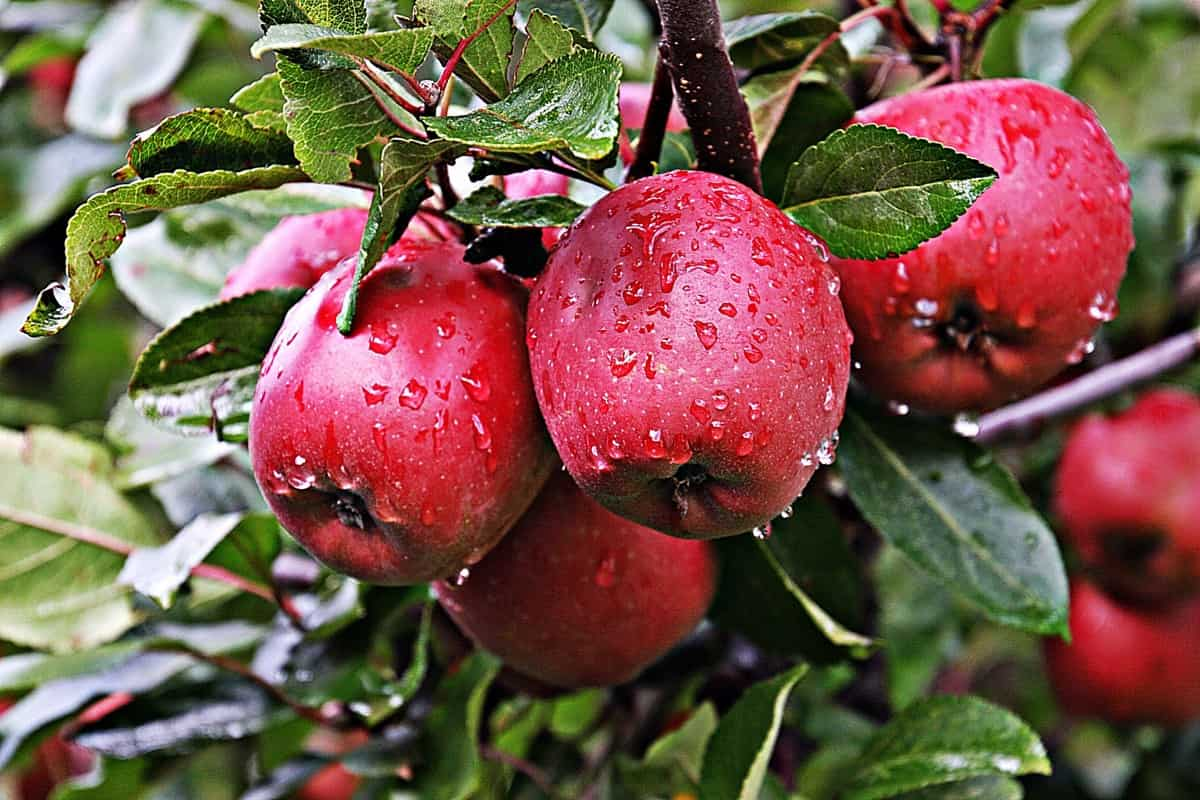
Shimla Apple farming in India
Shimla Apple
Shimla apples are derived from several varieties introduced in the Himachal Pradesh capital over time. Since ancient times, apples have grown wild in Central Asia. Apples from Shimla have a wide variety of appearances since they are generally referred to under their region-specific names. A round, oblate, or conical shape is common for the apples, which come in small, medium, and large varieties. Apples from Shimla can be smooth, taut, glossy, waxy to matte, or textured and covered in russet.
It has golden yellow to green base hues, covered in reds, crimsons, maroons, cherry red blushes, stripes, and striations, depending on the variety. The flesh beneath the surface typically displays ivory, white, or cream hues. Others have a grainy, crunchy, and chewy mouthfeel, while some have a fine-grained, crisp, and aqueous consistency. The varieties of Shimla apples vary in flavor from tangy and tart to mild, sweet, and delicate to very sweet, fruity, and subtle.
Areas famous for Shimla Apple cultivation
Shimla apples, botanically classified as Malus Domestica, are apple varieties grown in a specific area of India, belonging to the Rosaceae family. An Indian city in the Himalayan foothills, Shimla is located in northeastern India. Among the apple cultivars grown in Shimla are Red Delicious, Golden Delicious, Royal Delicious, Red Cap Valtod, Red Velox, Red Gold, Tydeman’s Early, Granny Smith, Oregon Spur, Scarlet Spur, Gale Gala, Auvil Early Fuji, Super Chief, Red Chief, and local Indian varieties.
Historically, Shimla apples were sold through distributors and sent to domestic markets across India under the Shimla name. However, the Himachal Pradesh government has established an agri-export zone that covers Shimla, Siramour, Kullu, Mandi, Chamba, and Kinnaur to increase exports. Apples will be exported to neighboring, western, and Southeast Asian countries at first.
In case you missed it: How to Start Green Apple Farming in India: A Production Guide to Planting to Harvesting
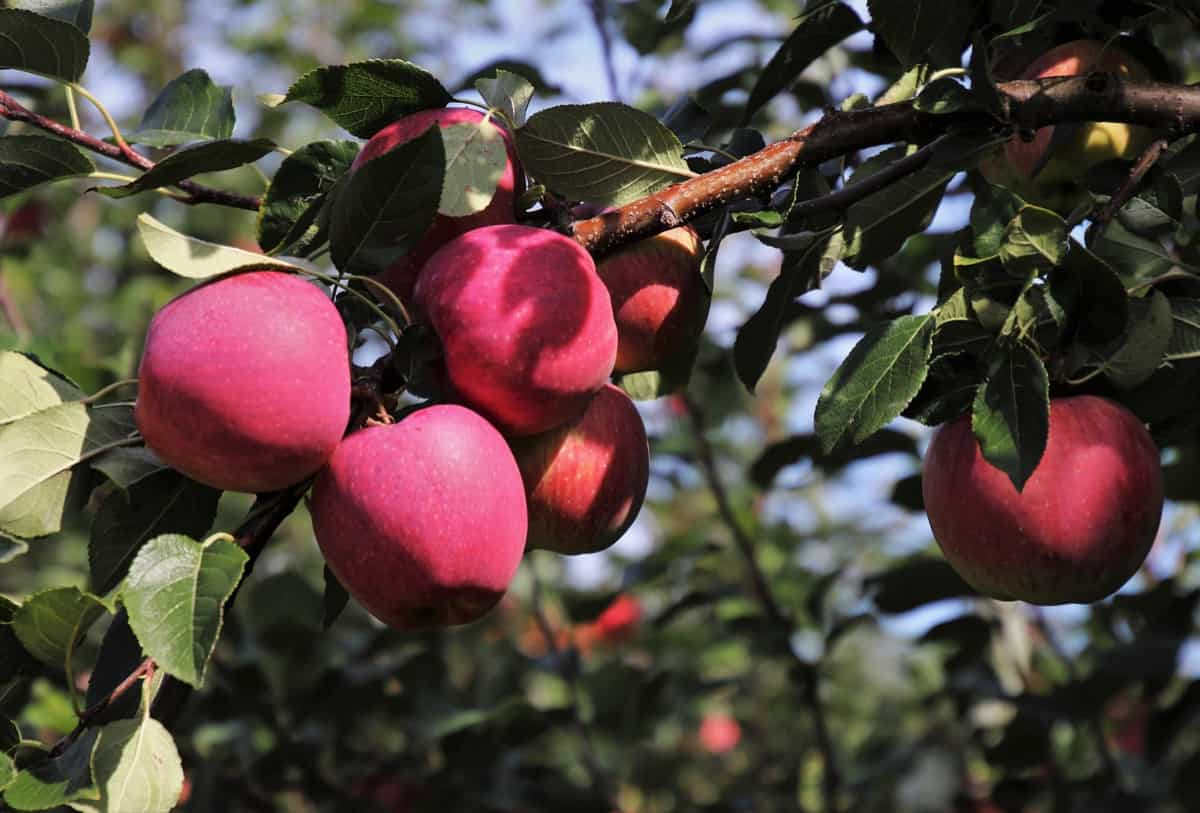
Agro-climatic requirements
During the winter season, apples can be grown at altitudes between 1,500 and 2,700 meters in the Himalayan range, which experiences 1,000-1,500 hours of chilling (when temperatures remain at or below 7°C). During the growing season, the temperature ranges from 21°C to 24°C. For optimum growth and fruiting, apple trees need 100-125 cm of space.
The rainfall that falls during the growing season is evenly distributed over the year. As a result, fruit quality is reduced, color is improperly developed, and fungal spots appear on its surface due to excessive rains and fog near the maturity period. Apple cultivation is also not recommended in areas exposed to high-velocity winds.
Soil requirements for Apple farming
The best conditions for apple farming are loamy soils rich in organic matter and pH values of 5.5 – 6.5. Another important factor is to ensure that the soil is not waterlogged so that efficient apple cultivation practices can be achieved. The stem diseases Canker and Papery Bark, as well as insects like stem and root borers, adversely affect apple trees in sandy-loam soils. By adding heavy quantities of farmyard manure/compost or leaf mold to shallow soils with gravels, shallow soils gravels can be suitable.
Soil preparation
Your apple tree needs a strong foundation, which is what soil preparation is all about. It involves replenishing minerals and nutrients with fertilizers or organic matter, breaking up, and loosening compacted soil. Any time in the year when the ground is not frozen or oversaturated with water is a good time for soil preparation.
Common soil amendments for Apple trees
- Manure
- Compost
- Sand
- Sphagnum or Peat moss (if native soil pH is too high or alkaline)
- Garden Lime (if soil pH is too low or acid)
Make sure your main field receives organic materials such as grass clippings and leaves that have been shredded. The grass and leaves will provide natural soil nutrients and loosen the soil. In preparation for spring planting, you can gather these in the fall.
It is possible to improve the composition of almost every soil type by adding organic materials such as compost. Sandstone particles are better able to retain moisture and nutrients when they are bound with organic materials. Furthermore, they break up clay and silt particles so that water can soak in and roots can grow.
Planting methods of Apple farming
In preparation for planting, 60 cm pits are dug two weeks in advance. There is good loamy soil and organic matter in the pits. It is done by scooping the soil from the pit and placing the soil ball in the center, keeping the roots intact. The remaining area is filled with loose soil and lightly pressed to remove air gaps. Seedlings are staked and watered immediately after planting. In the valleys, the hexagonal/square arrangement is practiced through the contour technique and is usually followed on slopes.
For quality apple farming, pollinator species are planted in the middle of the parent species. Plantation of burrow pits measuring 1 m x 1 m x 1 meter takes place between October and November. After blending properly, Farm Yard Manure (FYM), 500 grams of Single Superphosphate, and 50 grams of Malathion dust are added to each pit. Single irrigation should be followed immediately after apple planting.
Number of plants per acre
Apple plants can range in number from 80 to 500 on an acre. Therefore, there are four different planting density ranges for these plants. A low density is less than 120 apple saplings per acre, a medium density is 120 to 200 apple saplings per acre, a high density is 200 to 525 saplings per acre, and an extremely high density is more than 525 saplings per acre. Apple plant spacing and planting density can also be determined using a combination of scion and rootstock variety aids.
In case you missed it: How this Farmer is Earning 24 Lakh from Custard Apple Cultivation: 4 Acres Farming Sucess Story
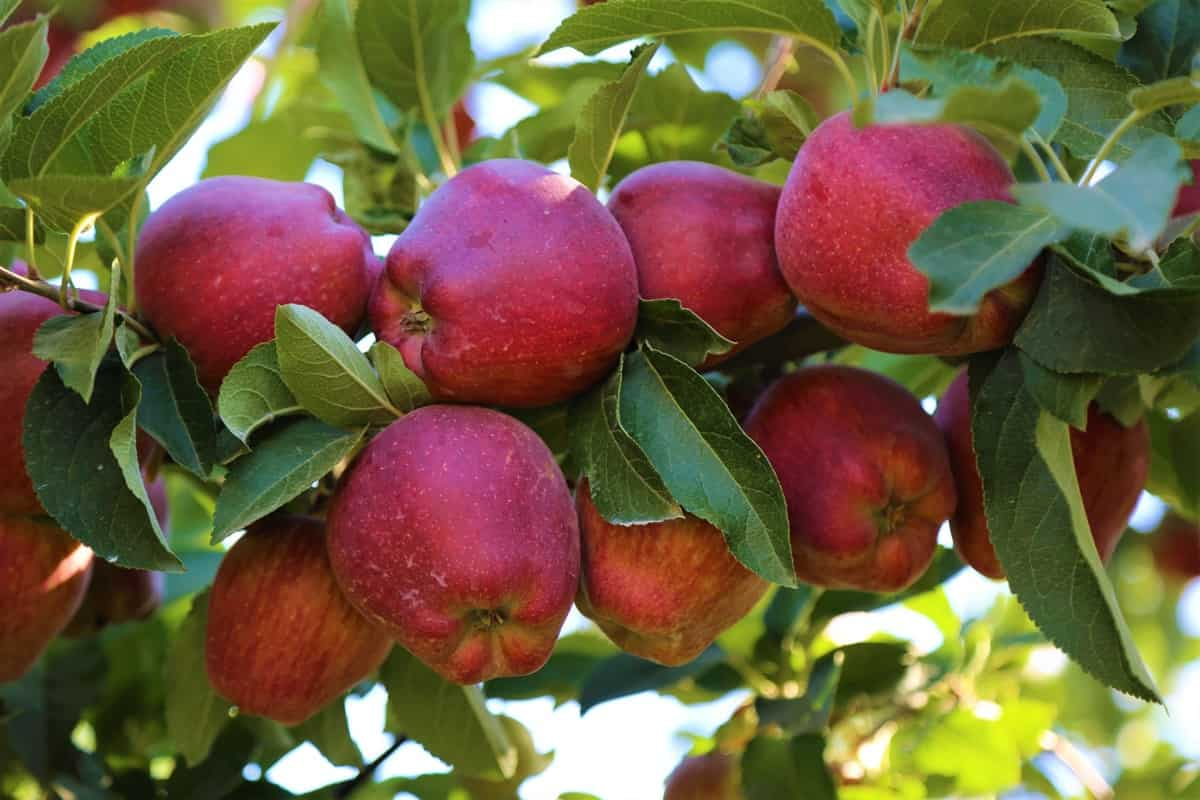
Irrigation requirement in Apple cultivation
Low soil moisture is particularly harmful to apple trees. In the growing season, water stress reduces the size and number of fruits and increases the June drop. When there are dry spells during critical periods, the success of apples depends largely on the uniform distribution of rain throughout the year. It is, therefore, necessary to provide supplementary irrigation. Poor fruit sets, heavy fruit drops, low production, and poor quality result from water stress conditions.
Water requirements are highest during April-August, and they are at their peak after the fruit set. The orchards are usually irrigated immediately after manuring in December and January. The crop is irrigated every 7-10 days during the summer. In the weeks following the fruit setting stage, irrigate the crop once a week. The color of the fruit is improved when water is applied during the fortnight preceding harvest. In the following weeks, irrigation is given at regular intervals until dormancy begins.
Fertilizers application in Apple farms
An apple tree’s root system can extend 1 1/2 times its canopy diameter at maturity. The feeder roots that absorb most nutrients grow within the top 12 inches of the soil, while the roots that absorb water and store excess nutrients grow about four feet deep. Therefore, fertilizers should be broadcast evenly over the surface, starting at least a foot from the trunk and extending beyond the drip line.
Only compacted soil or areas with excessive water runoff require deep-root feeding with holes in the ground or spikes. Ensure that areas previously fertilized with other lawn or garden fertilizers are not re-fertilized. After the leaves have fallen, fall is the best time to apply apple tree fertilizers.
Potassium
Fruit production on apple trees requires a large amount of potassium each year. In the spring, potassium can prevent frost damage to buds by improving fruit size and color. An average potassium application would be 90 grams per 100 square feet per year.
Calcium
The appearance of mild depressions on the apple’s surface and quick spoilage during storage are signs of calcium deficiencies in apple trees. The Calcium in lime, which also raises soil pH, should not be applied when deficiencies are evident in apples — it should be applied as soon as the soil pH requires it. A dose of 1 to 2 kg of lime per 100 square feet should provide sufficient Calcium, but the pH of the soil should not rise above 6.5 or 7.
Boron
Apple trees are also susceptible to boron deficiency. Symptoms of this deficiency include brown, corky spots inside the apple and dead buds at the ends of new shoots. Because Boron is so small, it is often easier to apply it every three to four years than as a yearly fertilizer unless the area to be fertilized is over an acre.
Nitrogen
Generally, nonfruiting apple trees require only nitrogen fertilizer, often in higher amounts than other nutrients in complete fertilizers. However, excessive nitrogen in apples and other fruit trees will cause new vegetation to outcompete the fruit for Calcium. Potassium absorption can also be hindered in soils with nitrogen-to-potassium ratios higher than 1 1/4 to 1. Therefore, nitrogen should only be applied when a deficiency is identified
Training and pruning
Apples require timely training and pruning to grow well and produce good-quality fruit. A rootstock’s growth habit and vigor are considered when training apple plants. The standard apple trees are also trained on a modified central leader system to receive proper light. Additionally, it minimizes the effects of heavy snowfall and hail on apple fruit. Under mid-hill conditions, spindle bush planting is best for high-density apple planting.
Thinning Apples
Thinning is one of the major techniques used to regulate fruit quality. During the alternate bearing cycle, apples produce small, poor-quality fruits due to heavy bearing. Therefore, it is possible to increase fruit quality and size by judicious thinning performed at the right stage of fruit development. Because manual thinning is cumbersome and expensive, chemical thinning is employed.
In apple farming, however, chemical thinners should not be applied in extremely hot and dry conditions, as they adversely affect absorption. Ensure that the entire canopy is sprayed thoroughly. Calcium deficiency can lead to chemical thinning; therefore, adequate calcium nutrition should be supplemented after thinning. For every 40 leaves, it is desirable to keep one fruit. Therefore, each spur will have one fruit spaced approximately 15-20 cm apart.
Intercropping in Apple cultivation
Compared to heavy feeder crops such as maize, oats, cabbage, strawberry, and control (clean cultivation), apple trees intercropped with leguminous crops like pea, red clover, and French bean produced higher fruit sets and early fruit maturity. Therefore, heavy feeder crops produced more fruits and matured earlier than control crops (clean cultivation).
Weed management in Apple cultivation
Weeds are plants that grow in the wrong place. The plants are usually growing directly under the trees in apple orchards. However, some plants establish in the grass, such as dandelions, may be unwelcome in apple orchards. Furthermore, weeds compete with trees for moisture and nutrients.
In case you missed it: Earning 6 Lakhs from 5 Acre Apple Ber/Jujube Farm: An Inspirational Story of a Farmer in India
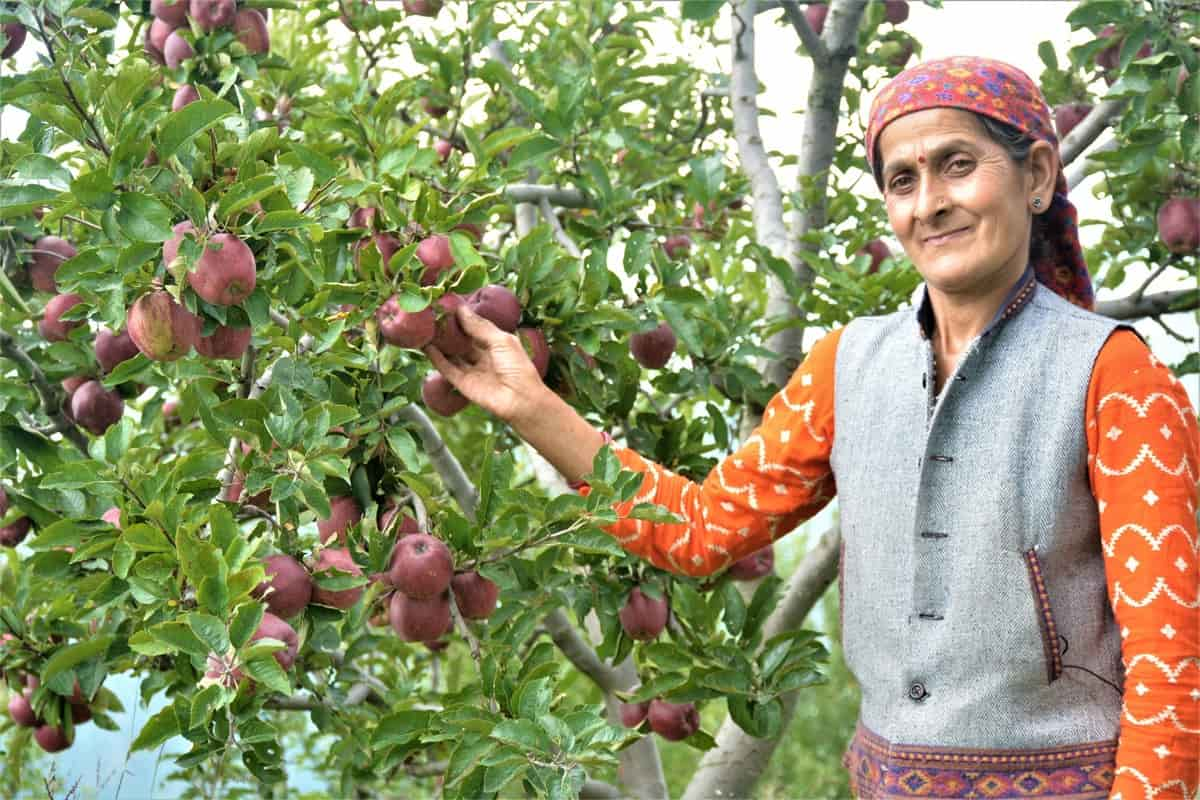
Black rot fungi, phytoplasmas, root-lesion nematodes, or tarnished plant bugs (e.g., on chickweed) are some examples of weeds that alternately host diseases, nematodes, or insects. Gammaxone, Paraquat (0.5% ), or glyphosate at 800 ml/ha as post-emergence herbicides will kill the weed maturing for four to five months.
Major diseases of Apple crops
Scab
Symptoms
- A lesion appears as olivaceous spots on the leaf’s lower side that turn dark brown to black and become velvety as time goes on.
- A feathery edge surrounds the spots on young foliage.
- The outline of the lesions is more definite on older leaves.
Chemical control and management
- Before flowering, spray Tridemorph 0.1%.
- In the bearing stage, spray Mancozeb at a rate of 0.25 %.
- In autumn, spray urea 5 percent before leaf fall and 2 percent before bud break to speed up decomposition.
Grey mold
Symptoms
- Fruits infected with the disease turn brown.
- In slightly intact, brown skin, the fungus advances into the inner flesh, resulting in a soft, watery mass of decayed tissue.
- In the typical, powdery, gray mold stage, the pathogen sporulates on the fruit’s surface.
Chemical control and management
- As a packing material, sodium bisulfate can release SO2 when contacted with moist air.
- There are also two-acetyl-3-hydroxyfurans and dibromotetrachloroethane that can control gray mold and sodium-o-phenyl phenate.
- Rapid cooling can be used to control grey mold.
Black rot canker
Damage symptoms
- When the leaves are unfolding, leaf symptoms appear early in the spring.
- Small purple spots appear on the upper surface of the leaves that enlarge into circular lesions 1/8 to 1/4 inch (3-6 mm) in diameter.
- Infected leaves become chlorotic and defoliate.
- A wound in the bark is usually associated with lesions resulting in canker formation.
Chemical control and management
- Prunings, dead wood, and mummified fruit should be removed and destroyed from the orchard. A timely application of appropriate fungicides will also help to control frog eye leaf spots and fruit rot.
- Using linseed oil, mustard oil, or castor oil to treat fruits
Major pests in Apple farming
Cottony cushion scale
Symptoms of damage
- Nymphs and adults extract the sap from leaves and twigs
- Yellowing of leaves.
In case you missed it: High Yield Hybrid Apple Varieties in India: State Wise
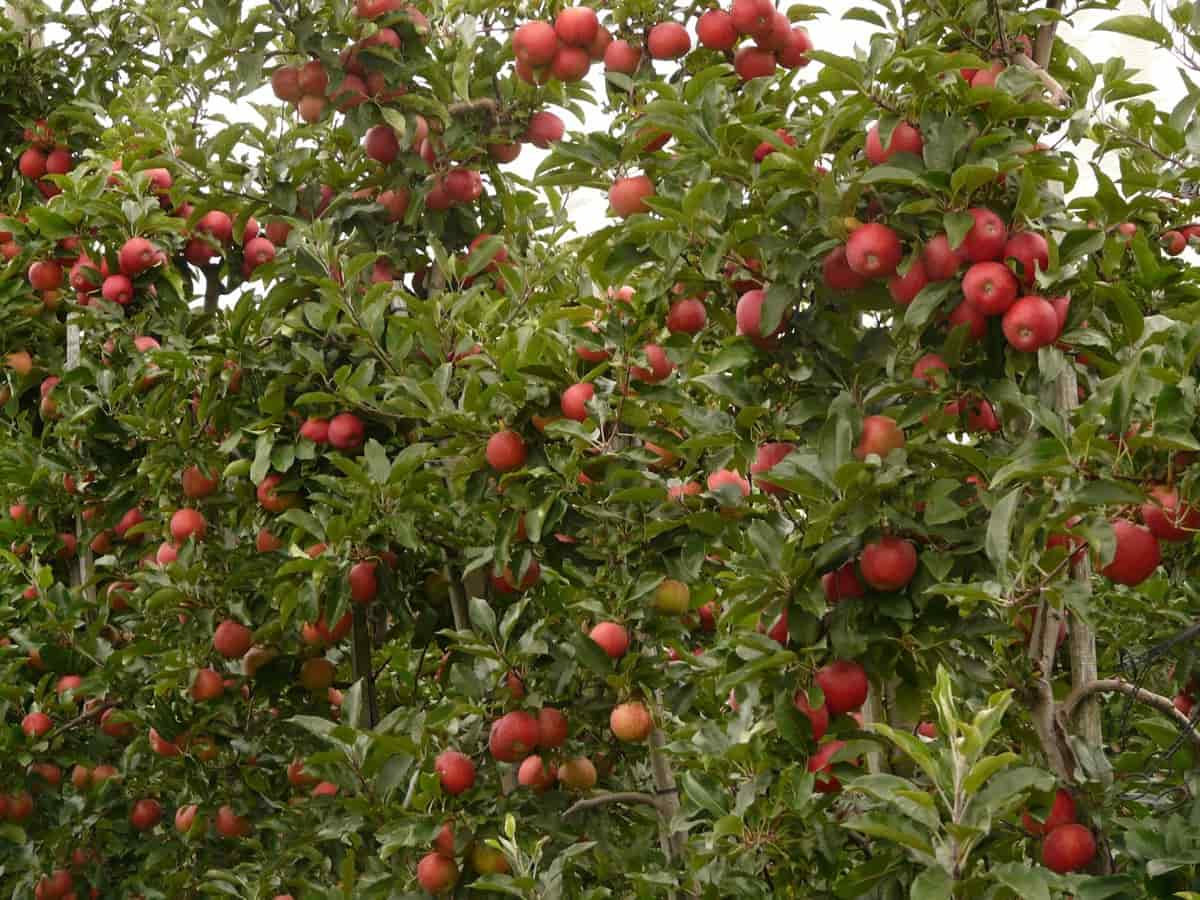
Control methods
- Rootstocks should be healthy and pest-free
- The infested plant parts should be collected and destroyed
- Spray application of 2% neem oil and 5% NSKE
- Spraying chlorpyriphos 20 EC 0.04% with a sticking agent
Apple Maggot
Symptoms
- Dimpled apples with cone-shaped pits
- Narrow brown tunnels in apple flesh
- Small pits indicating egg-laying scar
- Collapsed fruit
Control methods
- It must be treated to prevent its spread if it is found in quarantine. Malathion, carbaryl, and acetamiprid are the only available insecticides.
- It is possible to prevent larvae from burrowing into the soil by laying tarps under fruit trees with infestations. (Discard contents at the end of the season.)
- To control these pests, spray imidacloprid (systemic), carbaryl, or permethrin.
Codling Moth
Symptoms
- Larvae tunneling into the fruit’s center create deep entries
- The entry and exit holes are clogged with brown frass (excrement)
- It is common for fruit attacked during the first generation to drop prematurely
- Stings – shallow or aborted entries that have healed
Control methods
Insecticides that are more selective and lower in toxicity enhance populations of beneficial (predaceous and parasitic arthropods). However, native enemies alone cannot provide sufficient control. There has been some success in introducing parasitoids from native habitats of codling moths in Eurasia. For example, Trichogramma, a parasitoid that parasitizes eggs, has shown promise, particularly when combined with other low-toxicity tactics.
Apple harvesting
October and September are the best months for harvesting apples. Beginning in the 8th year, Appletree comes into effect. Apple productivity increases from the 8th to the 17th year. For the next 30 years, the product will remain stable. In general, apple trees live for 40 years or more, but their lifespan varies with climate conditions. Farmers harvest apple fruits before they are fully ripe.
In case you missed it: A Step-By-Step Guide to High Density Fruit Farming: For Guava, Banana, Mango, Pineapple, Lemon, Papaya, Litchi, and Apple
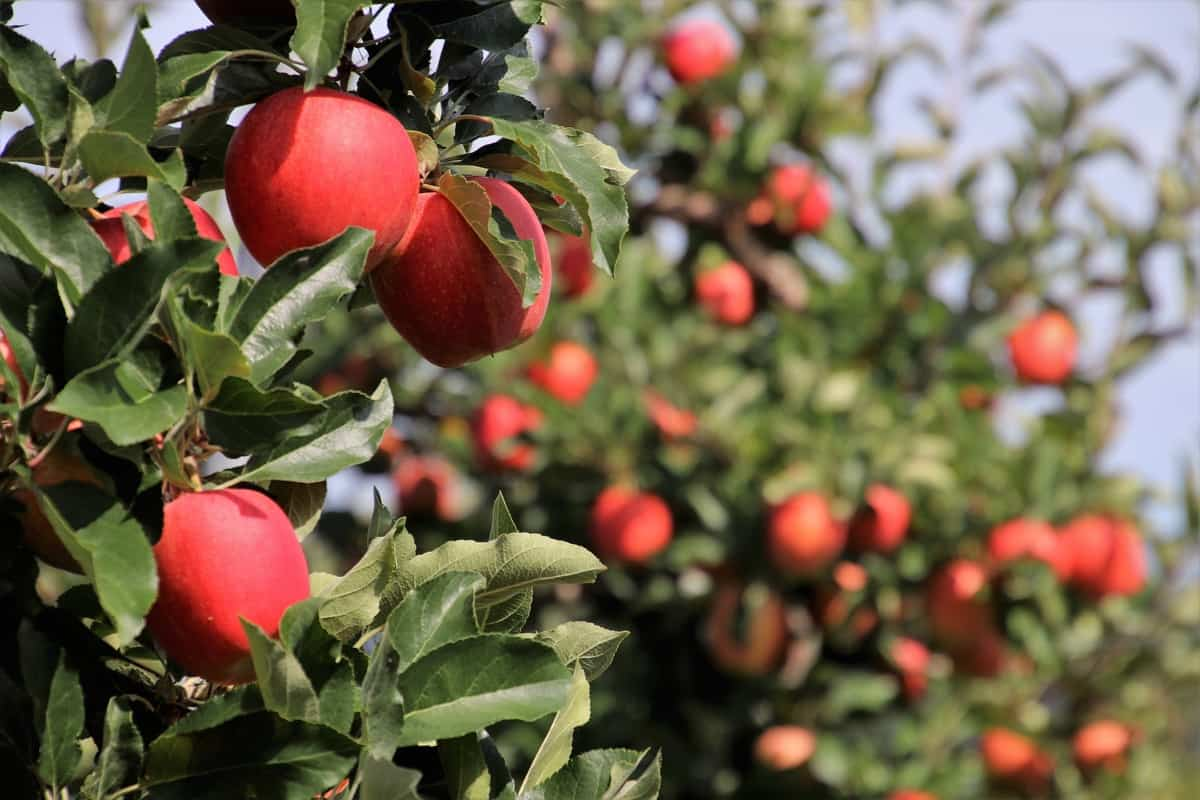
Post-harvest management
- Pre-cooling of Apples: Before packing apples, farmers placed them in a ventilated cool area to eliminate field heat. To grade, wrap, and pack apples in cartons, farmers must ensure that the surface of the apples is moisture-free.
- Grading Apples: Apple fruit is graded according to size, appearance, and quality. These grades are a, B, C, A, AA, AAA, or Fancy Class I and Fancy Class II, Extra Fancy.
- Apple storage: Farmers can store apple fruit for 4 to 8 months after harvesting since it has a longer shelf life than other fruits. Apple fruits should be stored in cold storage at about 0°C and 85-90% relative humidity.
- Apple packing: Apples can be packed best in wooden boxes, carrying about 10 kg or 20 kg of fruit.
- Apple transportation & marketing: Trucks are the best choices for apple transportation. Apples are transported by truck to the local market and local commission agents.
Conclusion
Himachal Pradesh’s Shimla and Kinnaur districts are well known for apples because they produce juicy red apples that are enjoyed around the world. Himachal has many apple-growing districts, including Shimla, Kullu, Mandi, Sirmaur, Kinnaur, and Chamba. Shimla, with its traditional apple-growing belt including Rohru, Jubbal, Kotkhai, and Kotgarh, is the state’s largest apple producer.
- Types of Pesticides Used in Agriculture: A Beginner’s Guide
- Economical Aquaculture: A Guide to Low-Budget Fish Farming
- 15 Common Planting Errors That Can Doom Your Fruit Trees
- How to Make Houseplants Bushy: Effective Tips and Ideas
- Innovative Strategies for Boosting Coconut Pollination and Yield
- Pollination Strategies for Maximum Pumpkin Yield
- The Complete Guide to Chicken Fattening: Strategies for Maximum Growth
- Natural Solutions for Tulip Problems: 100% Effective Remedies for Leaf and Bulb-Related Issues
- Revolutionizing Citrus Preservation: Towards a Healthier, Greener Future
- Natural Solutions for Peony Leaf and Flower Problems: 100% Effective Remedies
- Maximizing Profits with Avocado Contract Farming in India: A Comprehensive Guide
- Natural Solutions for Hydrangea Problems: 100% Effective Remedies for Leaf and Flowers
- The Ultimate Guide to Choosing the Perfect Foliage Friend: Bringing Life Indoors
- From Sunlight to Sustainability: 15 Ways to Use Solar Technology in Agriculture
- The Ultimate Guide to Dong Tao Chicken: Exploring from History to Raising
- The Eco-Friendly Makeover: How to Convert Your Unused Swimming Pool into a Fish Pond
- Mastering the Art of Delaware Chicken Farming: Essentials for Healthy Backyard Flocks
- 20 Best Homemade Fertilizers for Money Plant: DIY Recipes and Application Methods
- How to Craft a Comprehensive Free-Range Chicken Farming Business Plan
- Brighten Your Flock: Raising Easter Egger Chickens for Beauty and Bounty
- How to Optimize Your Poultry Egg Farm Business Plan with These Strategies
- Subsidy for Spirulina Cultivation: How Indian Government Schemes Encouraging Spirulina Farmers
- Ultimate Guide to Raising Dominique Chickens: Breeding, Feeding, Egg-Production, and Care
- Mastering the Art of Raising Jersey Giant Chickens: Care, Feeding, and More
- Ultimate Guide to Raising Legbar Chickens: Breeding, Farming Practices, Diet, Egg-Production
- How to Raise Welsummer Chickens: A Comprehensive Guide for Beginners
- How to Protect Indoor Plants in Winter: A Comprehensive Guide
- Ultimate Guide to Grow Bag Gardening: Tips, Tricks, and Planting Ideas for Urban Gardeners
- Guide to Lotus Cultivation: How to Propagate, Plant, Grow, Care, Cost, and Profit
- Agriculture Drone Subsidy Scheme: Government Kisan Subsidy, License, and How to Apply Online
- Ultimate Guide to Raising Araucana Chickens: Breed Profile, Farming Economics, Diet, and Care
- Bringing Hydroponics to Classroom: Importance, Benefits of Learning for School Students
- Ultimate Guide to Raising Polish Chickens: Breed Profile, Farming Economics, Diet, and Care
- Ultimate Guide to Raising Australorp Chickens: Profile, Farming Economics, Egg Production, Diet, and Care
- Silkie Chicken Farming: Raising Practices, Varieties, Egg Production, Diet, and Care
- Sussex Chicken Farming: Raising Practices, Varieties, Egg Production, Diet and Care